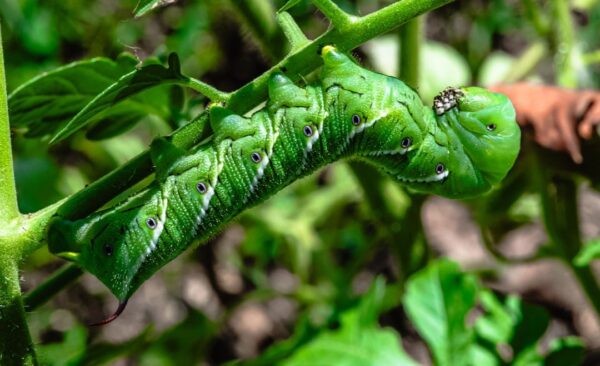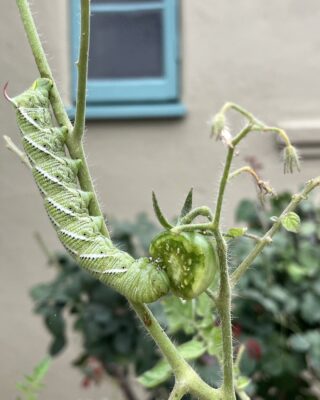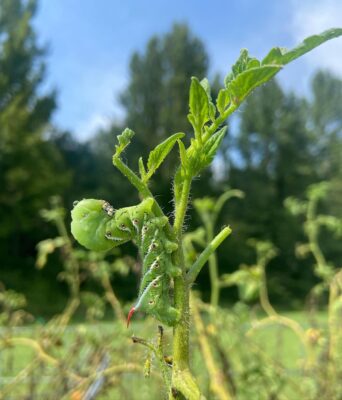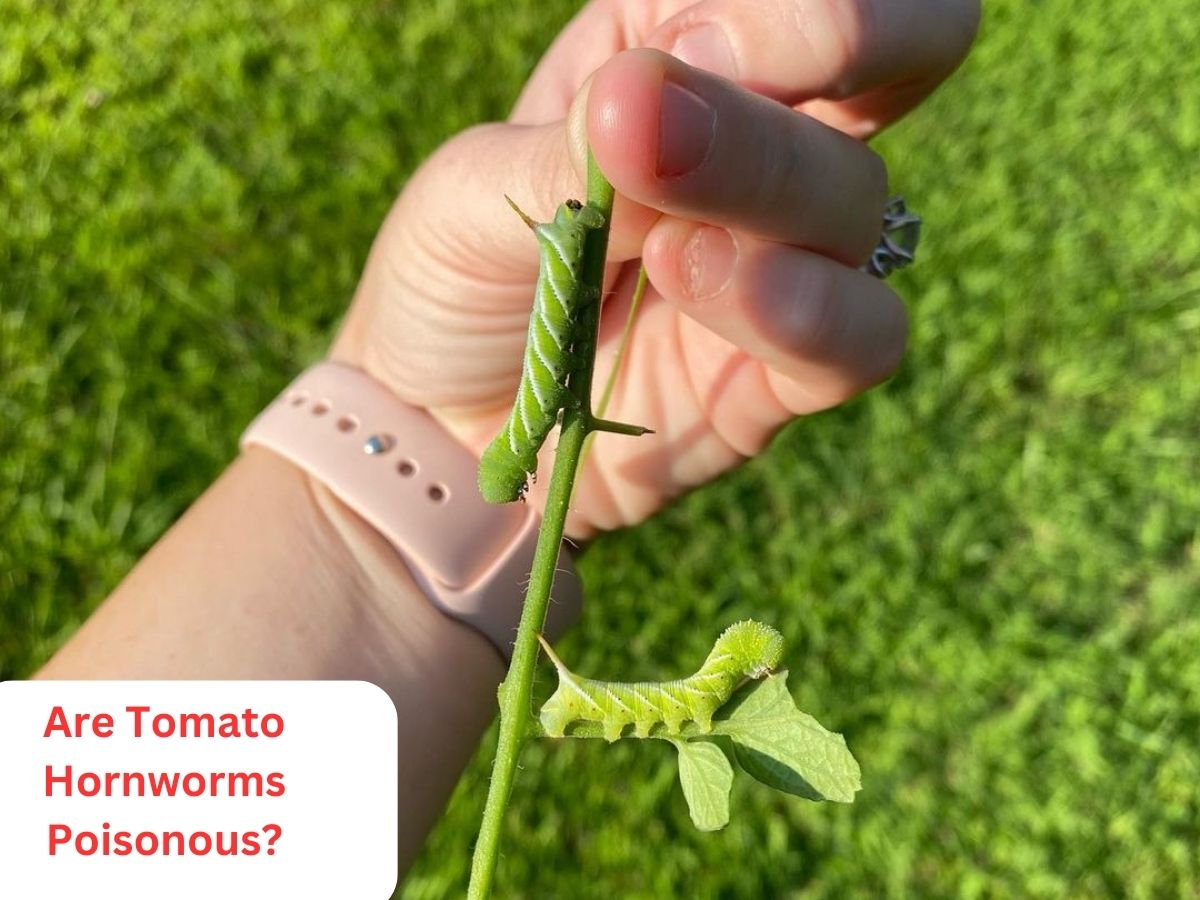Curious about tomato hornworms and their potential danger? Wonder no more – we’re diving into the intriguing question: Are tomato hornworms poisonous? These plump, green caterpillars with their striking horn-like protrusion might appear menacing, but the truth might surprise you.
Imagine you’re strolling through your garden, anticipating the joy of plucking sun-ripened tomatoes. Suddenly, you spot a tomato hornworm, its vivid green color and distinctive markings making it hard to miss. But wait, should you be concerned? Could these seemingly formidable creatures pose a threat to your precious plants and even your safety?
In a nutshell, the answer is no. Tomato hornworms might look fearsome, but they are not poisonous to humans. That’s right – despite their imposing appearance, you can handle them without any worry. Unlike some other insects that can deliver toxic bites or stings, tomato hornworms lack the harmful substances that could harm us.
However, while they might spare us their toxins, these caterpillars do have an appetite for destruction when it comes to plants. They can be a nightmare for your tomato, pepper, and potato plants, munching away at leaves and even delicate fruits. So, while they won’t harm you, your garden might be a different story.
In this article, we’re going beyond the surface to explore the fascinating world of tomato hornworms. We’ll debunk myths, unravel their eating habits, and provide you with insights on how to deal with them effectively. Get ready to discover the truth about these intriguing insects and arm yourself with the knowledge you need to protect your garden and make informed decisions.
What are Tomato Hornworms?
Tomato hornworms (Manduca quinquemaculata) are precisely that – fascinating and somewhat perplexing caterpillars that have a knack for surprising even the most seasoned gardeners. These plump, vivid green insects, often adorned with striking white V-shaped markings on their backs, are not only attention-grabbing but also a common sight in gardens where tomatoes, peppers, and potatoes thrive.
At first glance, their appearance might seem intimidating – a sizable body, vibrant coloring, and a horn-like protrusion that resembles a miniature unicorn’s horn. Yet, understanding the role and behavior of these intriguing insects is key to appreciating their presence in your garden ecosystem.
Hailing from the Sphinx moth family, tomato hornworms are the larval stage of an equally captivating moth species. While their appearance might lead to raised eyebrows, these caterpillars are a testament to the diversity and ingenuity found in the natural world.
Tomato hornworms are primarily known for their voracious appetite. With an insatiable hunger for foliage, they’re often spotted feasting on leaves, stems, and even the tender green fruits of tomato, pepper, and potato plants. As they munch their way through your garden, they can quickly decimate foliage, leaving your once-thriving plants in a state of distress.
In terms of habitat, tomato hornworms are not picky when it comes to where they set up shop. You’ll find them predominantly in gardens and agricultural fields where their preferred host plants, such as tomatoes and peppers, flourish. Their adaptability to a range of habitats contributes to their ubiquity and potential to impact your cherished crops.
Are Tomato Hornworms Poisonous to Humans?
Gardening lore often comes with its fair share of myths and misconceptions, and one that frequently raises eyebrows is the idea that tomato hornworms might pose a danger to humans. Let’s address this directly: Are tomato hornworms poisonous to humans? The answer is a reassuring no.
Tomato hornworms might sport a striking appearance, with their vibrant green bodies, distinctive white markings, and horn-like protrusions. However, their imposing exterior belies their true nature. Unlike some insects armed with venomous stingers or toxic bites, tomato hornworms lack the means to pose any harm to humans.
Handling tomato hornworms with your bare hands is not a cause for concern. These caterpillars won’t sting you, bite you, or release any harmful toxins upon contact. Their primary focus is devouring plant matter, particularly the leaves and stems of plants like tomatoes, peppers, and potatoes.
While tomato hornworms might be a threat to your garden’s plant life, they’re not a threat to your personal well-being. You can observe them, handle them, and even study their behaviors without fear of any adverse effects.
Understanding the distinction between potential threats to your garden and actual harm to humans is crucial, and in the case of tomato hornworms, you can rest assured that they fall into the former category, leaving you free to explore and appreciate the wonders of the natural world.
Of course, while tomato hornworms might not be poisonous in the conventional sense, they do carry a different kind of impact. Their insatiable appetite for plant matter can result in significant damage to your beloved garden greens. It’s this impact on your plants, rather than any potential harm to you, that warrants attention.
Can You Eat Tomato Hornworms?
Amidst the world of gastronomic exploration, the question of whether tomato hornworms are edible for humans might raise both eyebrows and appetites.
After all, considering the array of insects consumed around the world, could these hefty green caterpillars find their way onto our plates as well? Let’s unravel this culinary curiosity and explore whether tomato hornworms are a potential delicacy.
While insects have long been part of human diets in various cultures, the edibility of specific species, like tomato hornworms, varies significantly. Tomato hornworms are not typically considered a common or popular choice for human consumption. Unlike insects that are cultivated specifically for consumption, the idea of eating tomato hornworms is more of a rarity.
It’s important to recognize that the decision to consume insects is often influenced by cultural practices, availability, and tradition. In some cultures, insects are a rich source of protein and nutrients, forming an integral part of diets. However, tomato hornworms haven’t gained the same level of culinary recognition as, say, crickets or mealworms.

Caution and Consideration
Should you find yourself contemplating the idea of including tomato hornworms in your menu, there are some crucial considerations to bear in mind. First and foremost, if you’re not experienced in insect identification and preparation, it’s best to exercise caution. Misidentifying an insect could lead to unintended consequences.
Moreover, even if tomato hornworms are not inherently toxic, there’s the potential for ingesting pesticides or chemicals if they’ve been in contact with treated plants. Foragers and adventurous eaters alike should ensure they’re sourcing these insects from safe and pesticide-free environments.
In conclusion, while tomato hornworms might not be your average supermarket fare, they do present an unconventional culinary quest for those with a taste for adventurous dining. However, due to their relatively obscure status as an edible option and the associated considerations, approaching the concept of eating tomato hornworms requires both research and caution.
So, the next time you spot a tomato hornworm in your garden, remember that while they might not be a standard addition to your dinner table, they still contribute to the fascinating and complex tapestry of the natural world.
Do Tomato Hornworms Pose Any Threat to Plants?
Gardening is a delicate dance between nurturing and protecting your plants and contending with the forces of nature that seek to challenge their well-being. In this intricate ballet, tomato hornworms emerge as notorious players, capable of inflicting damage that can leave even the most resilient gardeners frustrated.
Let’s explore how these caterpillars pose a real threat to your precious plants, particularly tomatoes and their close kin.
Tomato hornworms may not be armed with fangs or venom, but their appetite for plant matter is a formidable weapon in itself. When these caterpillars descend upon your garden, they aren’t content with a mere nibble – they’re hungry for an all-out feast. Their feeding frenzy targets the tender green foliage of your tomato plants, as well as those belonging to related crops like peppers and potatoes.
The feeding habits of tomato hornworms are a force to be reckoned with. These caterpillars have an insatiable hunger that leads them to voraciously consume leaves, stems, and even the young, developing fruits of your plants. Their appetites are so voracious that they can strip entire branches of their foliage in a shockingly short period.
What makes their feeding behavior particularly concerning is the scale of destruction they’re capable of. A single tomato hornworm might seem small in comparison to your garden’s expanse, but when these caterpillars join forces, their collective appetite can lead to widespread damage. The result? Stunted growth, reduced fruit production, and a garden that bears the scars of their passage.
Stripped of Leaves: The Aftermath
The aftermath of a tomato hornworm invasion can be disheartening. As these caterpillars strip your plants of their life-giving leaves, the plant’s ability to photosynthesize and produce energy is compromised.
This can lead to weakened plants that are more susceptible to disease, stress, and even further pest infestations. The implications ripple through your garden, affecting not only the immediate season’s harvest but potentially impacting the long-term health of your garden ecosystem.
In essence, while tomato hornworms might not be poisonous to humans, their capacity to cause significant harm to plants is undeniable. As gardeners, it’s crucial to recognize their potential threats and implement strategies to manage their presence effectively. By understanding their feeding habits and the damage they can inflict, you’re better equipped to protect your garden’s vitality and ensure a bountiful harvest.

What About Pets and Livestock, are they harmful to them?
As gardeners, we’re not the only inhabitants of our outdoor sanctuaries. Our pets and livestock often share these spaces, sparking questions about their interactions with the various creatures that call our gardens home.
When it comes to tomato hornworms, the inquiry arises: What about pets and livestock? Do these curious critters pose any threat to our furry and feathered companions?
Rest easy, pet owners – when it comes to your furry friends, tomato hornworms generally pose little to no threat. Dogs, cats, and other domestic animals that might venture into your garden are unlikely to face any adverse consequences from interacting with these caterpillars. Tomato hornworms lack the venomous defenses or toxic bites that some other insects wield, making them relatively harmless to pets.
While your pet might curiously investigate a tomato hornworm, the likelihood of ingesting one is minimal. Even if they do nibble on a caterpillar, the potential for harm is low. However, it’s always a good practice to discourage your pets from indulging in garden snacking, as certain plants might be harmful to them.
Livestock and Their Encounter with Tomato Hornworms
For those who tend to larger animals like livestock, the story remains much the same. While livestock might show curiosity towards tomato hornworms, the caterpillars are unlikely to cause any significant harm if ingested. Tomato hornworms lack the potent toxins present in other insects that could pose a threat to larger animals like cattle, goats, or chickens.
In many cases, livestock graze on a wide variety of plants and insects as part of their natural foraging behavior. While it’s not common for livestock to make tomato hornworms a dietary preference, the occasional encounter is unlikely to have any adverse effects.
When it comes to the realm of pets and livestock, tomato hornworms are relatively benign. While they might not be a sought-after snack, their presence is unlikely to pose any health risks to our beloved animal companions.
However, as with any aspect of animal care, it’s wise to maintain a watchful eye and take measures to ensure the safety and well-being of your furry and feathered friends. By striking a balance between gardening and pet care, you can create a harmonious environment where all residents, whether human, animal, or caterpillar, can thrive.
Differentiating Tomato Hornworms from Toxic Lookalikes
In the intricate tapestry of the natural world, survival often hinges on the art of deception. Some creatures have mastered the skill of mimicry, adopting the appearance of other organisms to confound predators or secure a meal.
When it comes to distinguishing between tomato hornworms and their toxic lookalikes, the world of insects can be a labyrinth of intrigue. Here, we shed light on some of the lookalike species and provide clarity on whether they are indeed poisonous to humans.
- Tobacco Hornworm (Manduca sexta): A master of mimicry, this caterpillar bears a close resemblance to tomato hornworms. However, despite its appearance, the tobacco hornworm is not poisonous to humans. While it might startle you with its similarity, rest assured that its interaction with humans poses no harm.
- White-lined Sphinx Moth Caterpillar (Hyles lineata): Another skilled imitator, this caterpillar mimics tomato hornworms’ vivid green hue and white markings. Like the tobacco hornworm, the white-lined sphinx moth caterpillar is not poisonous to humans. While it might seem like a twin to the tomato hornworm, it’s not equipped with venomous defenses.
- Oleander Caterpillar (Syntomeida epilais): Resembling a striking work of art, the oleander caterpillar boasts vibrant colors that might remind you of tomato hornworms. However, this caterpillar should be handled with caution. While not deadly, its bright colors are an indicator of potential toxicity. Oleander caterpillars feed on poisonous plants like oleander, so it’s wise to avoid direct contact.
A Garden Guardian’s Guide
In your quest to differentiate between tomato hornworms and their lookalikes, knowledge becomes your most potent weapon. While tomato hornworms are harmless to humans, it’s essential to exercise caution when encountering caterpillars with vibrant colors or unfamiliar markings. By arming yourself with information, you can navigate your garden ecosystem with confidence, appreciating the beauty and complexity that both harmless and potentially toxic creatures contribute to the intricate dance of nature.

How to Tackle Tomato Hornworm Infestations
The battle for your garden’s well-being often extends beyond nurturing your plants to include safeguarding them from the encroachment of pests. Tomato hornworms, with their insatiable appetites, can swiftly turn your thriving garden into a battlefield.
But fear not – armed with the right knowledge and strategies, you can effectively manage and control tomato hornworm infestations. Let’s dive into the arsenal of techniques at your disposal.
Handpicking:
For small-scale infestations, don your gardening gloves and take a hands-on approach. Scour your plants for tomato hornworms and carefully pluck them off. Since these caterpillars are harmless to humans, don’t hesitate to handle them directly. This method might seem simple, but it can be remarkably effective in keeping their population in check.
Natural Predators:
In the intricate dance of nature, some creatures act as guardians against others. Introducing natural predators to your garden is a strategic move. Parasitic wasps, for instance, lay their eggs on tomato hornworms. As the wasp larvae develop, they consume the caterpillars from the inside out, effectively neutralizing their threat.
Birds: Feathered Friends in Pest Control
Harness the power of your avian allies – birds like blue jays, robins, and chickadees consider tomato hornworms a delectable snack. Encourage their presence by providing bird-friendly features like feeders, birdbaths, and shelter. By doing so, you create a welcoming environment that contributes to the ecological balance of your garden.
Organic Pesticides: Precision without Harm
When infestations escalate beyond manageable levels, organic pesticides offer a controlled solution. Neem oil, derived from the neem tree, disrupts the life cycle of tomato hornworms while minimizing harm to beneficial insects. Bacillus thuringiensis (Bt), a naturally occurring bacteria, serves as another effective option by targeting caterpillars specifically.
Companion Planting: Strategically Distracting
Strategically planning your garden layout can work to your advantage. By interplanting tomatoes with herbs like basil and marigolds, you create an environment that deters tomato hornworms while attracting beneficial insects. This harmonious coexistence supports plant health and reduces the likelihood of infestations.
Vigilance and Early Detection: A Gardener’s Watchful Eye
Perhaps the most crucial strategy is to remain vigilant. Regularly inspect your plants for signs of tomato hornworm presence – their large size makes them relatively easy to spot. Look for chewed leaves, frass (caterpillar droppings), or the caterpillars themselves. Early detection empowers you to take action before infestations spiral out of control.
Row Covers: A Barrier of Protection
Physical barriers can serve as a formidable defense against tomato hornworms. Row covers, made of lightweight fabric, can be placed over your plants to prevent adult moths from laying their eggs on the foliage. This proactive measure intercepts the infestation cycle before it even begins, giving your plants a head start.
Intercropping: The Power of Diversity
Take advantage of nature’s diversity by intercropping – planting different crops close together. By mixing tomato plants with other vegetables or herbs, you disrupt the monoculture that can attract pests. This natural diversity can confuse and deter tomato hornworms, reducing the likelihood of large-scale infestations.
Traps: Luring and Capturing
Set up pheromone traps to target adult moths seeking to lay eggs. These traps emit scents that mimic the pheromones released by female moths, attracting them away from your plants and into the trap. This technique disrupts the breeding cycle and curtails the growth of caterpillar populations.
Pruning and Sanitation: Stripping Their Hideouts
Tomato hornworms often find refuge in the dense foliage of plants. Regularly prune and remove lower leaves to expose hiding spots and discourage their presence. Additionally, clean up fallen leaves and plant debris to eliminate potential habitats and minimize the chances of overwintering pupae.
The battle against tomato hornworm infestations requires a multi-pronged strategy that adapts to the unique nuances of your garden.
By combining these techniques – from introducing natural predators to embracing strategic planting – you forge a holistic defense that harmonizes with the rhythms of nature. As you refine your approach, remember that the journey towards a thriving garden involves both persistence and the art of adaptation.
In the intricate dance of maintaining a flourishing garden, managing tomato hornworm infestations requires a multi-faceted approach. By combining vigilant observation, eco-friendly tactics, and a dash of strategic planning, you can create a garden ecosystem that thrives in harmony, with your plants flourishing and the pesky invaders kept at bay.
Conclusion
In the vibrant tapestry of your garden, the presence of tomato hornworms might seem like a daunting challenge. Yet, armed with knowledge, strategies, and a touch of ingenuity, you possess the tools to transform this challenge into an opportunity for growth and triumph. As we conclude our journey through the realm of tomato hornworms, let’s reflect on the lessons learned and the path forward.
From unraveling the mysteries of tomato hornworms’ appearance to debunking myths about their toxicity, we’ve ventured deep into the heart of these intriguing creatures. We’ve explored their interactions with pets, livestock, and even their mimicry tactics that can spark curiosity and caution alike.
The garden battlefield, where tomato hornworms threaten your plants, becomes a canvas for your creative gardening techniques. Through handpicking, natural predators, and companion planting, you forge a harmonious alliance that respects the delicate balance of nature. Your arsenal extends to row covers, traps, and vigilant nighttime searches – tools that demonstrate your commitment to protecting your garden’s vitality.
As the seasons change and your garden landscape evolves, remember that each challenge is an opportunity for growth. Tomato hornworms, with their voracious appetites and mimicry tactics, serve as a reminder of nature’s complexity and resilience. Your dedication to understanding, adapting, and employing a holistic approach transforms your garden into a sanctuary of balance and abundance.
So, step forward with confidence, armed with the wisdom to differentiate between true threats and nature’s imitators. With each meticulously tended plant, each vigilant inspection, and each strategy embraced, you elevate your role as a guardian of nature’s wonders. Your garden’s triumph over tomato hornworms becomes a testament to your dedication, perseverance, and the harmony that flourishes when humans and the natural world coexist in harmony.
